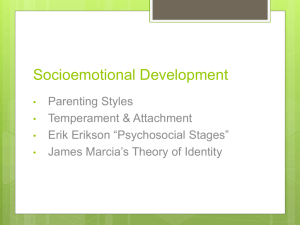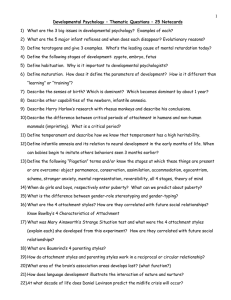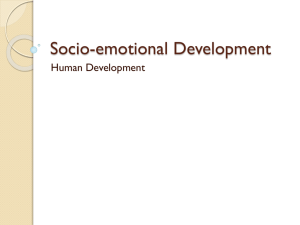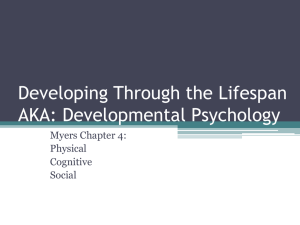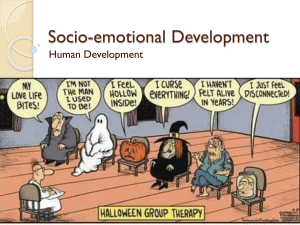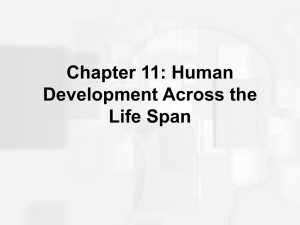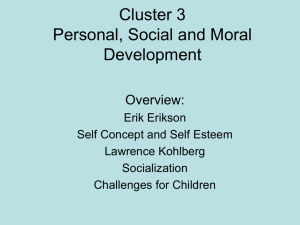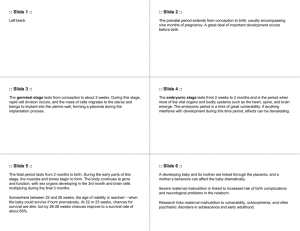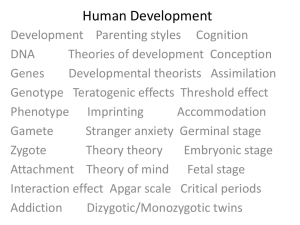File - CYPA Psychology
advertisement
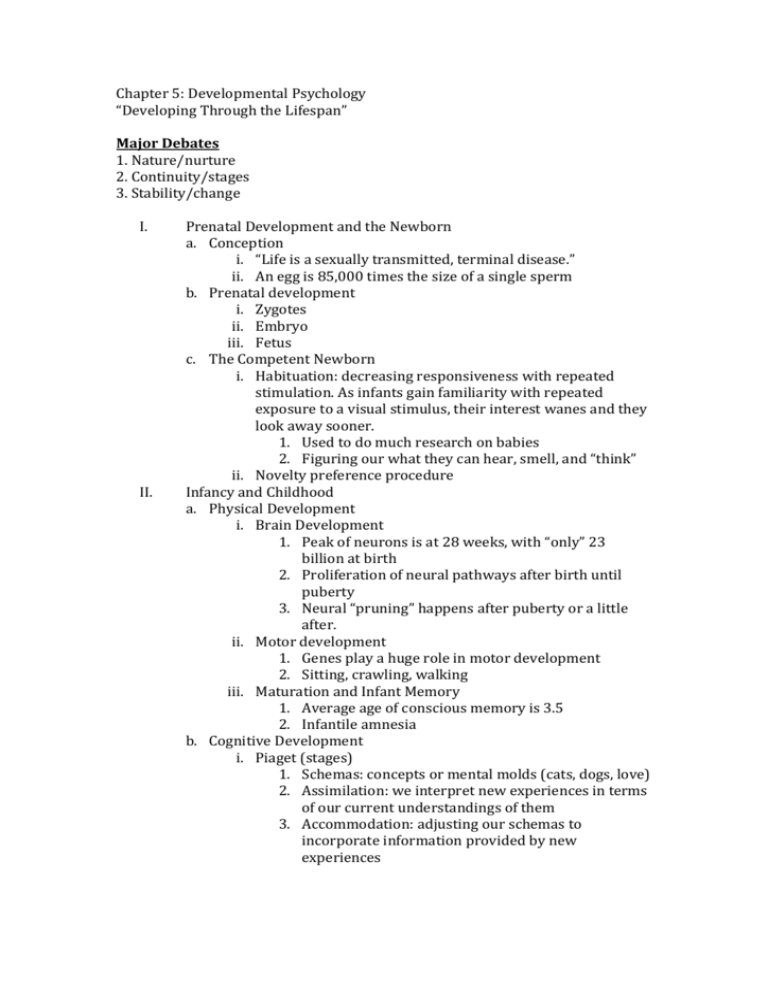
Chapter 5: Developmental Psychology “Developing Through the Lifespan” Major Debates 1. Nature/nurture 2. Continuity/stages 3. Stability/change I. II. Prenatal Development and the Newborn a. Conception i. “Life is a sexually transmitted, terminal disease.” ii. An egg is 85,000 times the size of a single sperm b. Prenatal development i. Zygotes ii. Embryo iii. Fetus c. The Competent Newborn i. Habituation: decreasing responsiveness with repeated stimulation. As infants gain familiarity with repeated exposure to a visual stimulus, their interest wanes and they look away sooner. 1. Used to do much research on babies 2. Figuring our what they can hear, smell, and “think” ii. Novelty preference procedure Infancy and Childhood a. Physical Development i. Brain Development 1. Peak of neurons is at 28 weeks, with “only” 23 billion at birth 2. Proliferation of neural pathways after birth until puberty 3. Neural “pruning” happens after puberty or a little after. ii. Motor development 1. Genes play a huge role in motor development 2. Sitting, crawling, walking iii. Maturation and Infant Memory 1. Average age of conscious memory is 3.5 2. Infantile amnesia b. Cognitive Development i. Piaget (stages) 1. Schemas: concepts or mental molds (cats, dogs, love) 2. Assimilation: we interpret new experiences in terms of our current understandings of them 3. Accommodation: adjusting our schemas to incorporate information provided by new experiences 4. Theory of Mind: being able to take another’s perspective (sally, anne, and the yellow ball) c. Social Development i. Origins of Attachment 1. Body contact a. Harlow and his monkeys 2. Familiarity a. Critical period b. Imprinting: Conrad Lorenz and his geese ii. Attachment differences 1. Ainsworth and the strange situation a. Secure attachment: 60% b. Insecure attachment 2. Result of parenting or result of temperament? 3. Erik Erikson a. Basic trust: a sense that the world is predictable and reliable iii. Deprivation of Attachment 1. “Hurt people hurt people.” 2. Cycle of abuse 3. Disruption of Attachment d. Self Concept i. Major achievement of childhood is a positive sense of self. ii. Self awareness begins when we can recognize ourselves in a mirror? 1. Dabbing paint on a child’s face…will they try to rub it off? e. Parenting Styles i. Authoritarian: impose rules and expect obedience III. ii. Permissive: submit to children’s desires iii. Authoritative: both demanding and responsive Adolescence a. Physical development i. Puberty ii. Primary sex characteristics iii. Secondary sex characteristics b. Cognitive Development i. Developing Reasoning Power 1. Abstract and hypothetical reasoning ii. Developing Morality (Kohlberg) 1. Preconventional 2. Conventional 3. Postconventional 4. Moral feeling a. Haidt’s social intuition: moral feelings precede moral reasoning 5. Moral Action a. As our thinking matures, our behavior becomes less selfish and more caring. b. Delayed gratification c. Social Development i. Erik Erikson IV. ii. Forming an Identity 1. Identity: our sense of self; according to Erikson, the adolescent’s task is to solidify a sense of self by testing and integrating various roles 2. Social identity: the “we” aspect of our self-concept; the part of our answer to “Who am I?” that comes from our group memberships 3. Developing a capacity for intimacy iii. Parent and Peer Relationships 1. Diminishing parental influence and increasing peer influence iv. Emerging Adulthood 1. 18-mid 20s (seniors, that’s you!!!) Adulthood a. Physical development i. Alzheimer’s and dementia ii. General bodily degeneration b. Cognitive development i. Aging and Memory 1. Decline in memory abilities, particularly short term 2. Prospective memory: remembering to do something in the future ii. Aging and Intelligence 1. Crystalized intelligence: our accumulated knowledge and verbal skills; tends to increase with age 2. Fluid intelligence; our ability to reason speedily and abstractly; tends to decrease during late adulthood. c. Social Development i. Social clock: the culturally preferred timing of social events such a marriage, parenthood, and retirement. ii. mid-life crisis/ mid0life transition
